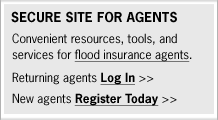
Northwest Rainy Season
Heavy rains from late October through March mark the rainy season in the Northwestern U.S., bringing the majority of yearly rainfall to the region from intense storms over the Pacific Ocean. Western Washington and Northwest Oregon have already experienced flooding early in this year's rainy season. November rains caused riverbanks to overflow and levees to be breached, resulting in millions of dollars in damages.
Winter rainy season doesn't end until April, yet many people may not think of flood insurance during the winter months. It is important to protect your property from flood damage all year-round. Only flood insurance offers financial protection from flooding.
HISTORY OF WINTER FLOODING
Winter flooding is a common and widespread natural hazard in the Northwest and threatens residents with thousands of dollars worth of damage to homes and businesses every year.
December 2005 – January 2006: Rain fell for 30 of the 31 days from December 18, 2005 through January 17, 2006 in northwest Oregon and southwest Washington, causing $2.4 million in total flood insured damage across the region.
December 1996 – January 1997: Damaging floods resulted from nearly two feet of heavy rainfall and widespread runoff from snow melt after unseasonably warm temperatures. Flooding caused more than $1 billion in damage.
February 1996: Rains were heavy across Washington and Oregon, with some areas receiving 12 to 20 inches of rainfall, and up to 30 inch totals were estimated in some higher elevation locations. For October 1 through February 11, precipitation amounts exceeded 130 percent of normal for Washington, over northern and western Oregon, western Montana, and northern Idaho.
PREPARE
Residents in areas susceptible to winter flooding need to prepare in advance for flood conditions. Before the threat of flooding becomes imminent, residents should:
- Purchase a flood insurance policy if they do not already have one
- Review their current insurance policy and become familiar with what is and is not covered
- Make a flood plan. Plan evacuation routes. Keep important papers in a safe, waterproof place.
- Itemize and take pictures of possessions
Winter Flood Risks
Coastal floods: Winds generated from intense winter storms can cause widespread tidal flooding and severe beach erosion along coastal areas.
Ice jams: Long cold spells can cause rivers and lakes to freeze. A rise in the water level or a thaw breaks the ice into large chunks that become jammed at manmade and natural obstructions. An ice jam can act as a dam, resulting in severe flooding.
Snowmelt: A sudden thaw of a heavy snow pack that often leads to flooding.
Mudflow (or debris flow): It develops when water rapidly accumulates in the ground, such as during heavy rainfall or rapid snowmelt, changing the earth into a flowing river of mud.
LEVEES AND FLOODING: PROTECTION WITH RISK
The West Coast has thousands of miles of levees—embankments along waterways, usually made of earth, designed to protect the lives and properties behind them from floods. However, no levee provides full protection from flooding and increased rains during the winter months can affect the ability of a levee to effectively contain rising waters. All levees are designed to provide a specific level of protection, and can be overtopped, or fail, in larger flood events. Levees also require regular maintenance to retain their level of protection. The fact is, levees can and do decay over time, and maintenance can become a serious challenge. When levees do fail, or are overtopped, they fail catastrophically—the flood damage may be more significant than if the levee was not there. For these reasons, the millions of people on the West Coast living behind levees need to understand the flood risks they face and take steps to address them.
If your community contains a levee, there are things you can do to protect yourself and reduce the impact of flood events. First, be sure you understand your risk for flooding. Local officials can provide more information about the levee and related flood risks based on the location of the property. Second, obtain flood insurance—it is critically important to financially protect your investment. Although areas behind levees that can be shown to protect against the one-percent-annual-chance flood will be shown on flood hazard maps as moderate-risk areas, FEMA strongly recommends flood insurance protection for all properties behind levees. Finally, please be aware of and always adhere to local evacuation procedures.
Consumers can visit FloodSmart.gov or call 1-800-427-2419 to learn how to prepare for floods, how to purchase a National Flood Insurance policy and the benefits of protecting your home and property against flooding.




500 C Street SW, Washington, D.C. 20472
Disaster Assistance: (800) 621-FEMA, TTY (800) 462-7585
U.S. Department of Homeland Security
FEMA Home | Contact FEMA |
Privacy Policy | Important Notices |
FOIA | USA.gov | DHS
